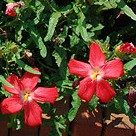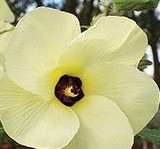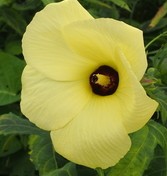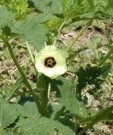
Abelmoschus is a genus of annuals and herbaceous perennials native to tropical Africa, Asian, and northern Australia and belongs to the mallow family, Malvaceae, that also include cotton, hollyhock, and hibiscus. The genus is made up of about fifteen species three of which have ornamental forms. One of these, A. sculentes (okra), is best known as a vegetable but also includes several ornamental varieties. All of the species are characterized by large flowers in red pink or yellow, need full sun, and fertile, moist, well-drained soil, and are propagated by seed. The genus name, Abelmoschus comes from the Arabic word, abu-i-mosk, meaning father of musk and refers to the scent of the seed.
Yellow Mallow (A. manihot)
 Native to Asia and parts of Australia, yellow mallow is a tender perennial grown as both a food crop and ornamental. The leaves are eight to twelve inches long, palmately divided into five to nine segments, and eaten for their high protein content. The flowers are up to six inches across, have lemon colored petals with deep purple throat, and last only one day. The inedible fruits capsules are three inches long, hairy, and distinctly five-sided.
Native to Asia and parts of Australia, yellow mallow is a tender perennial grown as both a food crop and ornamental. The leaves are eight to twelve inches long, palmately divided into five to nine segments, and eaten for their high protein content. The flowers are up to six inches across, have lemon colored petals with deep purple throat, and last only one day. The inedible fruits capsules are three inches long, hairy, and distinctly five-sided.
Size: 4-10’ H x 3’ W
Flower Color: Lemon yellow with purple throat
Bloom Time: Mid-summer to fall
Musk Mallow (A. moschatus)
 Musk mallow is a tender perennial native to Asia often grown as an annual. It has hairy, dark green leaves that are divided into three to seven widely spread, toothed lobes. The flowers are two to three inches wide, yellow with purplish centers, and last only a day. Cultivars are available with pink, crimson, or red with white centers. The inedible fruit capsules are two to three inches long and only slightly five sided.
Musk mallow is a tender perennial native to Asia often grown as an annual. It has hairy, dark green leaves that are divided into three to seven widely spread, toothed lobes. The flowers are two to three inches wide, yellow with purplish centers, and last only a day. Cultivars are available with pink, crimson, or red with white centers. The inedible fruit capsules are two to three inches long and only slightly five sided.
Size: 2-3’ H x 2 ‘W
Flower Color: Yellow with purple center; cultivars pink, scarlet, or red with white center.
Bloom Time: Summer to fall
Okra (A. esculentus)
 Although grown primarily for its fruit, this tender perennial native to West Africa, Ethiopia, and southern Asia, is also a valuable ornamental and several cultivars have been developed that expand the color range. The hairy leaves are four to eight inches wide, deeply divided into three to seven lobes and are usually dark green although a purple leafed cultivar is available. The flowers are two to three inches across and are yellow with a reddish center in the species, but pink, scarlet, or red often with white centers, in the cultivars. The edible fruit capsules are four inches long and must be harvested before they turn fibrous. The specific name, esculentus, comes from the Latin word meaning edible, good to eat.
Although grown primarily for its fruit, this tender perennial native to West Africa, Ethiopia, and southern Asia, is also a valuable ornamental and several cultivars have been developed that expand the color range. The hairy leaves are four to eight inches wide, deeply divided into three to seven lobes and are usually dark green although a purple leafed cultivar is available. The flowers are two to three inches across and are yellow with a reddish center in the species, but pink, scarlet, or red often with white centers, in the cultivars. The edible fruit capsules are four inches long and must be harvested before they turn fibrous. The specific name, esculentus, comes from the Latin word meaning edible, good to eat.
Size: 1-8’ H x 1-3’ W
Flower Color: Yellow with reddish center
Bloom Time: Summer to fall